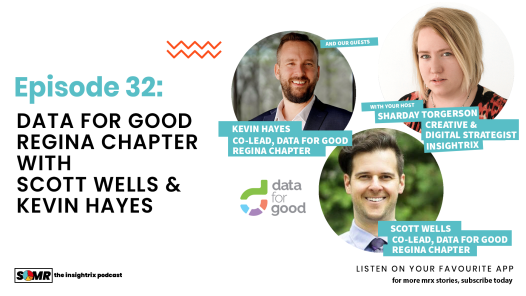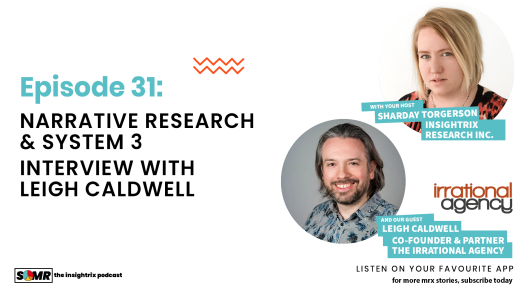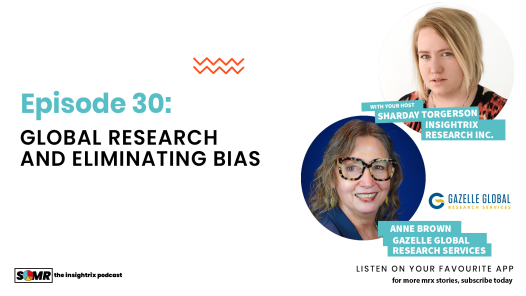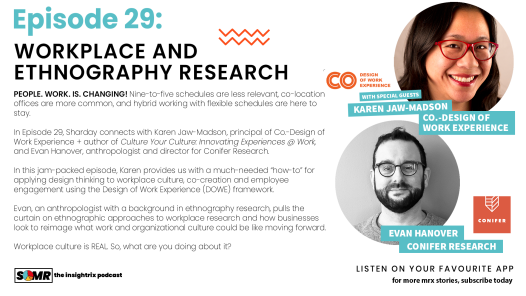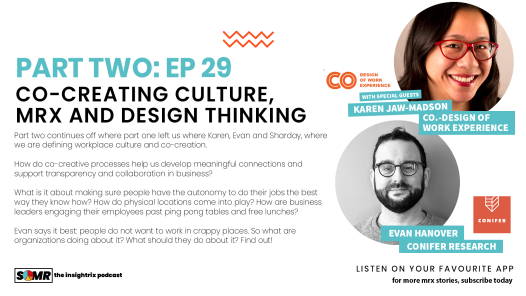Sharday Torgerson:
What we got here. So I got the, essentially the culture at the heart of the way companies think about decision making, the way that they should implement those changes, which I think we kind of nailed on. I have one last question that kind of wraps up in the final thoughts, but it’s more or less, what do organizations need to know about their workplace to move forward and how can businesses jump right in employee research? What can they do? So it’s almost as if we can kind of discuss all those nuances and then maybe, and that might be a question for Evan or yourself. Like both of you come at it from such a…
Karen Jaw-Madson:
I have a list of starting points. You know, I think that ties in well.
Evan Hanover:
Yeah. I don’t know. Hire me. Karen is kind of the starting point, right?
Sharday Torgerson:
That is, I would argue. That’s probably a good way to start. I got an idea actually, to even roll that back in, but you know, the amount of information that I am digesting, I feel like I’m right back in university. Let’s be honest here. I love it. So no, I, this is great. This is all very rich information. And honestly I think the whole conversation around organizational culture, the fact that market research can be a really invaluable tool to support understanding the employer’s needs, I think is really interesting. I know lots of people are talking about out it right now. I know lots of people are looking at practical ways to do it. I think you two are probably the most experienced people put in one room to actually have this conversation. So thank you so much for kind of bouncing these ideas off.
Sharday Torgerson:
I know for a fact that this will be invaluable to people really starting to look at their workplace culture or maybe they’re halfway through the pandemic and they’re like, I just don’t even know what’s going on anymore. And maybe some of this stuff is really ringing true for them. Hopefully not the case. Hopefully everyone’s doing well out there, but you know, I think it really stems to this point that no one owns culture and it’s got to really be developed from the ground up, which is really interesting. So it’s important for businesses to maybe recognize that cultural needs need to happen from that space to be able to create the ownership, the innovation it’s better than anything a business can do from, from the top down. At least that’s what I’m hearing.
Karen Jaw-Madson:
I just want to add, no one owns it but everyone can contribute to it.
Sharday Torgerson:
Absolutely. Yeah. And, and giving and giving employers a way to do so I think is pretty important in this conversation. So as, as an employer or an employee, sorry, excuse me, as an employee, but even then feeling empowered is important to me. So it makes sense, but I love how this is kind of naturally leading us into the next segment and that’s how businesses can go about gauging what their work culture may look like. So Karen, your book is wonderful, your culture innovating experiences at work, and it really touches on how organizational culture is an untapped asset. And potentially we mentioned a liability for businesses, yet we’re kind of talking about how a lot of folks may not know how to manage their culture with proficiency. I know your book touches really well on this and knowing that, why don’t you share with our listeners, what the origin may be of the design of the workplace framework and how this concept is helping businesses dig deep.
Sharday Torgerson:
Place framework and how this concept is helping businesses dig deeper, challenge boundaries, surface new ideas, and potentially support how corporate decisions or organizational cultural decisions are being implemented.
Karen Jaw-Madson:
Yeah, thanks. This book really, and Evan’s known me a long time. So he’s seen this journey. This book was born really out of a frustration with how often we raise culture as this huge factor. And we talked about the news headlines earlier, right? They always point to culture, always. And then we have all this stuff out there that talks about, “Yeah, that’s a good culture, or that’s a bad culture.” And there might be archetypes, right? So there might be archetypes, there might be clues or hints, or these are things you can do, but there was nothing that actually built the capability of cultivating culture and managing it. So, really this framework which is Design of Work Experience, which was really meant to provide a step-by-step how-to, for intentionally creating culture on the front-end. As opposed to remedially, let’s just say, right?
Karen Jaw-Madson:
So, it’s really meant to fill what I saw as a gap. Not only that, this is work that I do. There’s far more work to be done than what one person can do. I literally gave everything away in this book because I feel it’s very important to empower organizations, to be able to leverage culture as that asset that we talked about earlier. So, what it does is it takes a deep understanding of an organization’s unique context, and allows them to intentionally co-design that aspirational future, with both business and people in mind, right?
Sharday Torgerson:
Yep.
Karen Jaw-Madson:
And I know you have the image of the framework, but there’s four main components. It’s the combination of design and change processes, enabled by leveraging and building capability and engagement throughout. So, that’s the four main components. Now, as we’ve already demonstrated in this conversation, is that culture is complex work and it needs to be explored in digestible, focused parts. And so, I really don’t want to oversimplify this because this framework is better lived than spoken or read about, to be honest.
Sharday Torgerson:
Sounds like just like culture, so.
Karen Jaw-Madson:
Absolutely, absolutely, great point. So, when I say it needs to be put into digestible pieces, there’s five phases. There’s understand, which we’ve been talking a lot about, that first phase, when we talk about ethnographies. The second phase is create and learn. The third is decide, and then the fourth is plan, and the fifth is implement. So you see so many organizations skip steps, and they go from problem to solution, and they miss a lot along the way. And so all of these are organized as a series of iterative learning loops, each with its own specific set of activities. And therefore, you’re always focusing on the present. It’s whatever’s in front of you at the moment. And what DWE does, that’s what I call it for short, is that it yields an in-depth understanding of the current state. It provides a design for the future state, and a roadmap and the action plans to get there.
Karen Jaw-Madson:
So, that’s really something that I hope and I desire to contribute, to the benefit of better workplaces, and better work experiences. Because believe me, every time I hear the stories and I do, my heart breaks for people. Why are we willing to accept less than ideal workplaces? And why are we willing to not live up to our own full potentials as individuals and as organizations? And we’re our own worst enemies. And so, I think equipping us to be able to break some of those cultural patterns so to speak, right? Allows us to disrupt and hopefully create a different future. So, one of my favorite quotes is that, “You’re perfectly designed for your current results.” I got that from David Cooperrider of Appreciative Inquiry. And so if you want different results, you have to do different things, right? So, that’s really what I’m hoping to do, is to help disrupt that in the good way. Yeah.
Sharday Torgerson:
I love that. And I think even in the later aspects of our conversation, we were exploring elements of the later-stage activities within DWE. And any more insight maybe you’d like to add on the thinking of this? And how maybe does the change process of the Design of Framework Experience, allow maybe businesses to consider certain types of insights while planning and implementing decisions? I know we touched on it a little bit, but.
Karen Jaw-Madson:
I think the key part is that, this people centered design piece is something that A, doesn’t always happen, but then you have to pair that with the change processes. And organizations today, they’re often managed separately when they shouldn’t be, right? So, I didn’t make this stuff up. I’m building upon decades and decades of research and understanding about organization. And I’m curating, I’m bringing the pieces together to make sure that we’re getting different results. So, that’s the important piece is, you can have, like I said earlier, the best design, right? If you don’t implement it, it’s the same thing with innovation, right? It’s great to have discovery, right? But innovation has to be adopted, to have the impact. Again, I know people debate that point all the time. But I think it’s important that the people aspect is incorporated into it.
Karen Jaw-Madson:
So when organizations are saying, “Hey, we have an intimidating business problem or challenge,” they don’t always think about, “Well, what do we need to make sure people can be aligned with that strategy for the results that we’re hoping for?” They’re just shoving it down people’s throats, right? Are they not? And it doesn’t work.
Sharday Torgerson:
Hacking it up with a nice little bowl and putting it on a PDF and handing it so that you sign once you read it maybe, so.
Karen Jaw-Madson:
God, I remember those days.
Sharday Torgerson:
Gone or the days of the printed PDFs. Now they’re just downloadables on your internet. So, I’m just kidding. But, I do love that aspect. And I think that’s a really interesting point. Even in the fact that, organizations need to know about their workplace culture, to the extent that… What am I trying to say here? It’s not a fake it til you make it, because I think that’s what a lot of businesses may be doing. Is that again, and I’m not using as an example, but what if we were to build this wonderful hybrid environment and then just let everyone loose? Just give them the wild, wild west and not actually really nurture the environment so that folks were actually utilizing it the best that it could be. We’re experiencing some nuances of that because we got a lot of new technology as well.
Sharday Torgerson:
So, even though we may feel like we did a really good job as a facility management team to tackle those culture nuances at Insightrix, we are still every day running into problem based scenarios where sometimes it’s the pandemic. Sometimes it’s our own internal thinking where a lot of the times we’re having to readdress what we’re doing and stuff.
Karen Jaw-Madson:
Yeah. But, readdressing it almost in real-time and not letting it stew. Right? Because, better workplaces-
Sharday Torgerson:
Exactly.
Karen Jaw-Madson:
perform better. And so even those companies, they were like, “Well, what about those companies that are really doing well and they have a crappy culture?” A, they don’t last forever that way, it’s not sustainable. But B, think about what they’re leaving on the table. Right?
Sharday Torgerson:
Yep. And talent management, as you said, is a big thing. And I think I can, even within my young career, see within a lot of folks that I know within my own network, during the pandemic, how that’s changed. How they see their own career, their environment’s very important to them. And they’re willing to speak on it.
Karen Jaw-Madson:
I like that you used the word career, and not job.
Evan Hanover:
Yeah. I think that you can’t fake it till you make it is really important here, because it’s more like, remake it until you remake it until you remake it until you remake it.
Karen Jaw-Madson:
I Like that.
Sharday Torgerson:
Yeah. That’s good.
Evan Hanover:
It’s because the other thing is, Karen, bracketing is really not a great approach to anything. And I think when you talked about how the implementation of this work is done elsewhere. How there’s a siloing or a division of labor that doesn’t allow this holistic approach. I think that happens institutionally, where you have, this is your responsibility. But it also happens temporarily where you’re just like, “Here’s an initiative and it’s done.” And this is an initiative that is never done. And I think the Design of Work Experience is really in some ways what human resources should involve into. And it should be thought of as a porous department or where it’s not this thing over there that gets involved with legal stuff and bureaucracy, that it’s much more about development and nurturing a culture and making sure that people stay involved in this process.
Evan Hanover:
Because, the other thing is if people take away nothing from this, what I want them to take away is this is not going to be a simple bounded solution and initiative that just gets done and then everybody runs off into the golden future where we all have wonderful workplace experiences. This is something that companies are going to get, if not wrong, more likely 1/2 right. It is going to be incremental. And it gets back to this idea that culture is practice. And culture is behavior and culture is dynamic. And culture needs to be lived. Because if you think that you’re just going to fix this once. And, this is not to say that you need outside consultants like myself or Karen in there for the rest of your lives. We don’t need to put a sleeping bag under one of the desks and live there forever. That’s not what we need to do.
Sharday Torgerson:
I thought that was ethnography in a nutshell, Evan, so.
Evan Hanover:
At some point you roll up your sleeping bag and you come back home and you have to sit down and write your ethnography. But what it is it’s creating a better process, which is by its nature, open to change. And by its nature, inquisitive. And by its nature, humble. That knowing everything ain’t going to happen. So, why don’t you accept that and be open to the possibility that things are going to evolve, and.
Karen Jaw-Madson:
Yeah, I’m glad you brought in HR. I actually conducted a recent interview about my thoughts around the future of HR. So, I’m happy to share the link if that’s of interest.
Sharday Torgerson:
Absolutely. Absolutely.
Karen Jaw-Madson:
So, but Evan, I think you hit the nail on the head there.
Sharday Torgerson:
I love it. So, I think we’re wrapping up and those are really great final thoughts. I might pose one last question for you both. We keep talking about culture being at the heart of the way companies think about decision making. And the way that they should implement those decisions. We keep talking about the nuances of employee research and how businesses can do it. But, where’s a good place to start if a business is interested in maybe looking into their organizational culture?
Karen Jaw-Madson:
So, I have some thoughts on that if I can jump in.
Evan Hanover:
Def, go first.
Karen Jaw-Madson:
And I write about this in the book about on-ramps and off-ramps. I get a lot of, “When’s the right time to start?” There’s never a bad time. Okay? Let me just start saying that. Right? Early on in the pandemic, same thing. It’s like, “We’re going to wait till we’re back in the office and do our culture work.” Again, it’s still happening. Right? So, some starting points, if it helps people out there, you can start with an intimidating business problem or challenge where you need people to succeed. You can go into specific needs within a function or an organization. Any aspect of the employee life cycle can be designed as an experience with culture in mind. Any people interactions, we’ve touched upon so many in this conversation. Even building organizational capability. Example, how do we become more innovative?
Karen Jaw-Madson:
Guess what? There’s some skill in that, but it’s also the culture people, right? Or any identified priorities. Every organization should have a set of priorities and that’s a wonderful starting point for your culture. So, it’s all about what kind of culture is needed in order for us to do this, right? Or how do we make sure people are excited, engaged, inspired, and how do we do amazing things together, right? So, those are some starting points. But, I’ll give you another David Cooperrider quote which is, “Our worlds are formed by the questions we ask.” And so the moment you begin questioning the current state, that’s once change starts to happen. Right? So, I encourage all of you to take a step back and start putting on those traveler’s eyes, as they say in design thinking and start asking some questions. Because, you never know what you’re going to discover.
Sharday Torgerson:
As they say, or while as I say, the world changes and research listens.
Karen Jaw-Madson:
I like that.
Sharday Torgerson:
Yep.
Karen Jaw-Madson:
I’m going to write that down.
Sharday Torgerson:
Yes.
Evan Hanover:
So, I’m going to make that quote my own. Because, I think our worlds are often comprised of the meaning we share. And I think one of the ways, as you start to think about what in my culture do I want to change? Often, the question should really be, what in my culture works? And I’ll give you a very, seemingly small insignificant example from Conifer. So, Conifer, like every other company got hit really hard in March of 2020. We wrapped up the projects we were able to wrap up. There were a few winding down and then everything else ground to a halt. And, it’s hard to remember back that far because it feels like the world has changed 15 times in the last, now coming on 23, 24 months.
Evan Hanover:
But we were very concerned about our culture and what it felt like to work at Conifer. We were highly collaborative. We’re a small office. Everybody, I think is if not friends, friendly with everybody else. We work together really closely. We’re a very flat hierarchy. We also geek out, because a lot of us are anthropologists. We geek out about the things that make Conifer, Conifer. And one of the things that makes Conifer, Conifer, is we have a ritual which every Thursday at three o’clock, the office manager comes around with chocolate. It’s chocolate Thursday. And it’s not one of these traditions where the company buying the foosball table for everybody to play at. It was actually a very organic tradition. And it started when one of my former colleagues ran a foul of our former director of design. And, he relives this through out.
Evan Hanover:
And he showed up with a bunch of chocolate muffins one Thursday. Which are effectively frosting with cupcakes. And we were all in early and she was like, “What’d you do?” And he’s like, “What are you talking about?” She’s like, “What’s with these? What did you do?” And his reaction was, “What are you talking about? It’s chocolate Thursday.” And that was his way of, even though everybody knew that he got in trouble. And after that, a few of us would go out and get some chocolate. And eventually, the company adopted it. And so what we decided-
Karen Jaw-Madson:
I love that.
Evan Hanover:
Because we understand that rights and rituals are really important. As leadership, we’re like, “Look, we’re not going to go under based on whether we send a chocolate to everybody at their houses. That’s not going to be what makes or break us. But it may be the thing that holds us together, feels like we’re still working together in a certain way, even though we are manifestly not working together in a certain way. And we’ll send every couple of months, two months worth of chocolate, Thursday chocolate to every employee. And also it’s become really important as people have been onboarded during the pandemic. Here it is. Here’s a ritual that is… Because culture is also about continuity. It’s about tradition and it’s about feeling like you have ownership of what’s going on by being part of those traditions. And so, I’m not saying that every company should have something equivalent to that, but look at it, look at what the shared meaning is that helps build people’s worlds, and use those as anchors to push the culture you want to have forward.
Karen Jaw-Madson:
Now you just gave-
Sharday Torgerson:
Someone took my fish feeding. Sorry. I was going to say someone took my fish feeding duties at Insightrix here when we moved office locations. And let me tell you, that was a hard moment for me, so.
Evan Hanover:
But you have to instill someone else with that-
Sharday Torgerson:
It was so responsible, I felt good.
Evan Hanover:
Responsibility, that’s a passing of a torch. And that’s the movement to a new status, a new social role. Those are important too, but.
Sharday Torgerson:
Yeah, well, yep. Yep. And I don’t think they got it, but at the same time I really let them know that I really enjoyed it. And yeah, so.
Karen Jaw-Madson:
I think what both of you have expressed just now and through this conversation is something that I saw, Evan, you took me back to March of 2020, as-
Evan Hanover:
You’re welcome.
Karen Jaw-Madson:
What I observed from a cultural standpoint is with this shift that happened in March of 2020, what it did was exposed the cultures that were already there. So, the companies that had great cultures, this pandemic gave them an opportunity to demonstrate why they’re great. That’s what you’re just saying, Evan. You talked about the ritual, right? And conversely, those that were troubled to begin with, really struggled. Right? And I think that part of it is contributing to this great resignation for that reason. And so, I really think that I hope through this conversation, we’ve convinced some people about the importance of culture and how important it is to not only people, but the business as well. So, but I just love hearing about your experience. I mean, push back on me if you don’t agree with this. But I’m curious, was that you experience?
Evan Hanover:
Yeah, one of the other methods we use is deprivation research. Which is, you have things that are part of people’s routines, you take out a key part of those routines.
Karen Jaw-Madson:
Like Sharday, with the fish.
Evan Hanover:
Yeah, exactly. That’s a good example. And then you see how people respond to this thing that was always there to the point where people didn’t really think about it, how do people respond to that? What do you do to fill that hole? And what deprivation research does, is it moves a part of the background into the foreground, so that you have to address it, but you can do it in creative ways and you can change positively. And the pandemic has been a giant global deprivation research experiment. And I think, as you were saying, it has foregrounded some of the best parts of our individual, organizational, but just general cultures. And also foregrounded some of the not so good ones. And, I think that’s given us an opportunity to reflect and engage and act in a really, hopefully positive way, as long as we do it openly, and with that curiosity and humility and engagement.
Sharday Torgerson:
That change transformation, right? I think we’re really starting to experience what that may look like specifically from an organizational culture perspective. So, that’s a great point. So, I think we landed where we needed to go. So, I want to thank obviously both our guests today, both Karen and Evan for joining us in such a thought provoking topic. I think this is something we could probably sit here and talk about all evening, but I know for more information, we got a lot of it here, because there’s lots of stuff that we actually unpack today. But for any information on the framework, the methodologies that we discuss in today’s episode, please visit the podcast player on the website podcast.insightrix.com. We’ll have all the links within the description and everything that you learned today.
Sharday Torgerson:
To learn more about Karen and the DWE framework, visit the website or pick up Culture Your Culture: Innovating Experiences @Work on Amazon. And again, a link will be provided in the description. To learn more about Evan ethnography, and he touched on it very little, the Deprivation Research, done at Conifer, visit their website, which I will also link below. And again, if you enjoyed today’s topic, it’s been a day. Give us a like, share or subscribe on any favorite podcast player. And don’t forget to leave us a review, if you learnt anything new. So until next time.
Evan Hanover:
Thanks for having
Karen Jaw-Madson:
This was fun, yes.
Evan Hanover:
Take care.
Sharday Torgerson:
Awesome. Good job. Awesome. That was great. That was awesome. My head feels big now, though. Yeah. I love them. We used to do them in person quite a bit. We were really localized at first, then we really started to expand. But, I’m really enjoying the platform that we’re using, Riverside, even though it took us 15 minutes to figure out the audio. So again, do apologize on my end. I told you I’d be prepared and still messed around.
Karen Jaw-Madson:
Technology is good until it doesn’t work. So it’s fine.
Evan Hanover:
I have to jump because my wife and baby have been exiled upstairs, but this was great. Yeah. Thank you.
Karen Jaw-Madson:
Evan, let’s keep talking too, so-
Sharday Torgerson:
Thank you.
Karen Jaw-Madson:
Thank you for including me in this. I really appreciate it.
Evan Hanover:
My pleasure. I think it worked out great, so.
Sharday Torgerson:
Yeah, you guys did awesome. Thank you so much. And I will follow up next week on everything. Okay?
Karen Jaw-Madson:
Okay.
Sharday Torgerson:
Awesome. Bye, both.
Karen Jaw-Madson:
Bye, take care. Timing wise [crosstalk 01:42:18]
Sharday Torgerson:
Be careful.


